Researchers discovered eight well-manufactured throwing spears in an Ice Age coal deposit near Schöningen, Germany. They are calling these the oldest human tools. What can forensic science reveal about the people who made them?
Portions of the Schöningen open pit coal mine were set aside for archaeological work decades ago. In 1997, Hartmut Thieme of the Lower Saxony State Office for Heritage described three spears that he found in the Helmstedt lignite coal mine.1 They were constructed to such exacting specifications that replicas of them performed as well as modern javelins in throwing tests.
The site also contained fossils of fruit, other vegetation, birds, fish, and thousands of mammal bones representing rhinoceros, elephant, cows, red deer, many smaller mammals, and mostly horses—including many horse bones with cut marks from butchery. Such an assemblage of various animals and human remains clearly indicate that a severe Ice Age storm washed them into a low-lying area and quickly covered them with mud.2 Indeed, it had all been submerged for centuries until engineers drained the area to expose and mine its coal.
Archaeologists from the University of Tubingen found eight additional spears from the Schöningen coal mine. They appear to have been mass produced. Like javelins, their center of gravity was balanced toward the front of each spear. The news release said, "The spears and other artifacts as well as animal remains found at the site demonstrate that their users were highly skilled craftsmen and hunters, well adapted to their environment—with a capacity for abstract thought and complex planning comparable to our own."3
The additional spears corroborate the significance of the 1997 spears, which had rewritten evolutionary notions of early Europeans as brute scavengers, not "highly skilled craftsmen." Archaeology magazine reported, "They suggest that early man was able to hunt, and was not just a scavenger."4
The earliest direct or indirect evidence of tools shows every indication of human-like expertise in manufacture. For example, people butchered animals in Africa long before these German spears were used.5 Ancients ground grain and decorated baskets.6 And the earliest religious temple was of the highest quality, currently under excavation in Turkey.7
If human evolution were true, one would expect to find that the earliest ape-like humans produced clumsy efforts, not the refined tools and artifacts known around the world. Therefore, it comes as no surprise to Bible believers that early human artifacts such as well-formed throwing spears show that ancient humans were fully human.8
References
- Thieme, H. 1997. Lower Paleolithic hunting spears from Germany. Nature. 385 (6619): 807.
- The coal deposits occur in sequence of six, indicating perhaps six storms with catastrophic water movement. For Ice Age storm models, see Vardiman, L. 2003. Hypercanes Following the Genesis Flood. Proceedings of the Fifth International Conference on Creationism. Pittsburgh, PA: Creation Science Fellowship. R. L. Ivey, Jr., ed., 17–28.
- Skilled Hunters 300,000 Years Ago. Universitat Tübingen news release, September 17, 2012.
- Kouwenhoven, A.P. 1997. World's Oldest Spears. Archaeology. 50 (3).
- Thomas, B. Human Tool Marks Found from 'Lucy' Era. ICR News. Posted on icr.org August 18, 2010, accessed September 18, 2012.
- Thomas, B. Discoveries Show Early Mankind Was Advanced. ICR News. Posted on icr.org March 17, 2010, accessed September 19, 2012.
- Thomas, B. Oldest Temple Topples Evolutionists' History of Religion. ICR News. Posted on icr.org January 12, 2012, accessed September 18, 2012.
- Although evolutionists overestimated the ages of these artifacts due to uniformitarian assumptions, these spears could probably be some of the earliest human artifacts. Since they were found in coal deposits associated with the Ice Age, and since people required some time to migrate from Babylon to modern Germany, this places these artifacts relatively soon after the Flood, which is roughly dated to 2,500 B.C. by standard Bible chronology. For example, see Sewell, C. 1995. Biblical Chronologies Compared. Bible & Spade. 8 (1): 20-31.
Image credit: Lower Saxony State Office for Heritage. Copyright © 2007 NLD. Adapted for use in accordance with federal copyright (fair use doctrine) law. Usage by ICR does not imply endorsement of copyright holders.
* Mr. Thomas is Science Writer at the Institute for Creation Research.
Article posted on October 8, 2012.
















